How to Stabilize Video in After Effects [3 Methods]
This article will teach you three basic techniques for how to stabilize video in After Effects. You will discover how to stabilize footage using Warp Stabilizer and the Tracker Panel. Additionally, we recommend AnyEnhancer- an AI video enhancer and stabilizer – for those who wish to enhance the video quality of their videos and remove shakes within a short time.
Are you facing shakiness in any of your essential videos? It is rather simple to fix shaky videos in Adobe After Effects. Below are three basic procedures to stabilize your video in After Effects. Even if you are a novice or already have some experience, following these methods will be easy. You will learn how to make smooth and professional-looking videos by familiarizing yourself with Warp Stabilizer and Tracker Panel tools. Moreover, if you want an even faster solution, you can try AnyEnhancer – an AI video stabilizer and enhancer – to fix all at once. So, let’s begin to learn how to stabilize video in After Effects!
Table of ContentsHide
Can I Stabilize a Video After Recording?
Yes, you can always reduce the blurriness and shakiness of a video even after shooting it. There are various tools to stabilize a video and one such tool is Adobe After Effects. Adobe After Effects Warp Stabilizer analyzes and stabilizes motion in a video. In addition, you can use motion tracking in the Tracker Panel to increase video stabilization by tracking a specific spot in the video.
AI technologies such as AnyEnhancer can assist you in swiftly improving and stabilizing your films. These methods solve problems like shakiness or blurriness in videos and give them a professional image.
How to Stabilize Video in Adobe After Effects
Stabilizing video using Adobe After Effects is one of the most effective techniques to repair shaky footage. After Effects includes features such as the Warp Stabilizer, which analyzes the movie and automatically eliminates superfluous motions.
You can also choose motion tracking and manual keyframing to stabilize required points in your video and have more control. These features help improve video quality and give a polished look to your projects. In the next sections, we will explain the methods below for using these tools step by step to stabilize your video easily.
Method 1. Using Warp Stabilizer
The Warp Stabilizer is one of the simplest and most reliable tools for stabilizing video in Adobe After Effects. This tailored software evaluates the enclosed video and optimizes the motion to make it more professional.
It is most suitable for starters as it does not need much manipulation, and even a few clicks will produce a stunning effect. Warp Stabilizer especially assists in minimizing unwanted motion, whether you have basic or complicated video footage. Here are the steps for using Warp Stabilizer to stabilize your video:
Step 1. First, open After Effects and import the video you want to stabilize by selecting “File”> “Import”> “File.”
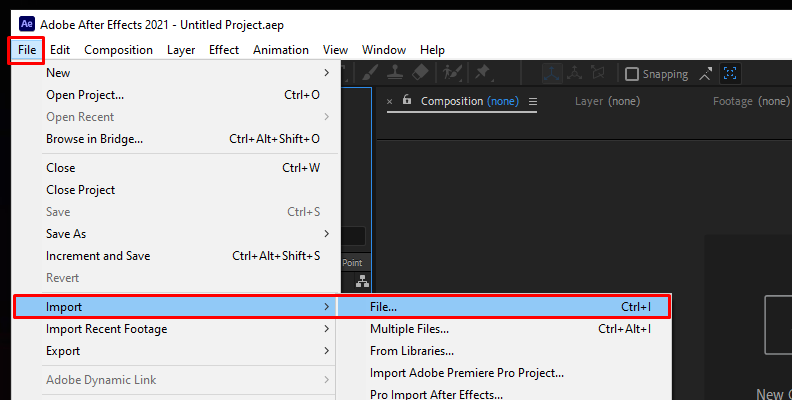
Click Import
Step 2. Right-click on the video in the Project panel and choose “New Composition From Selection.” This creates a composition that matches your video’s settings.
Step 3. In the Timeline panel, click on the footage layer to select it.
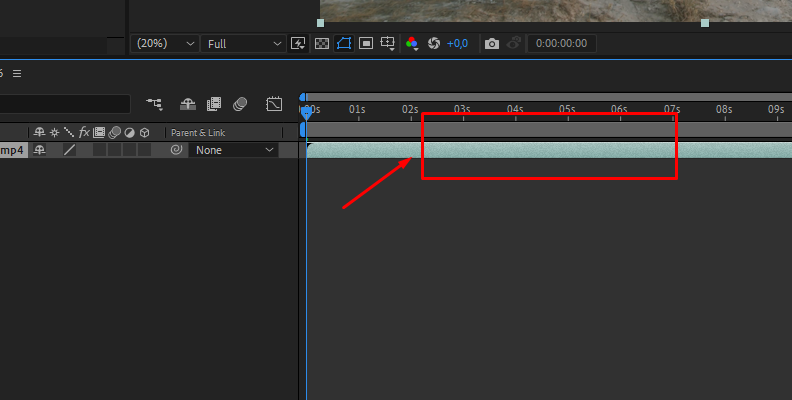
Click Footage Layer
Step 4. In the top menu, click “Animation,” then choose “Warp Stabilizer VFX” to apply the effect.
Step 5. Check the settings in the Effects Control panel. The default is fine but adjust “Smoothness” for better control.
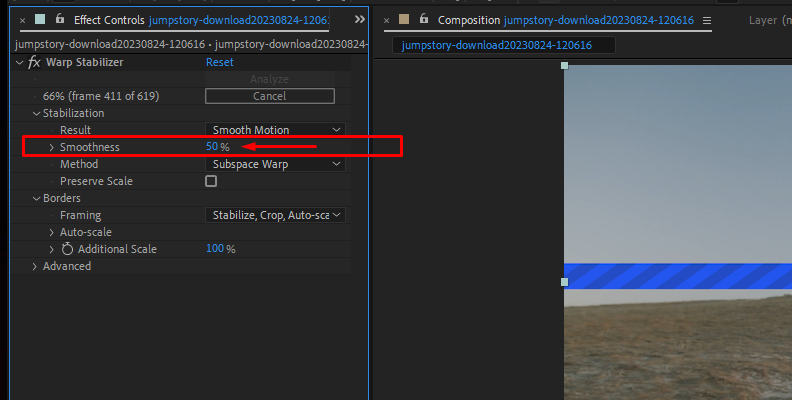
Change Settings
Step 6. Once you’re happy with the settings, After Effects will analyze the footage; the time this takes depends on your video’s length and complexity.
Step 7. When the analysis is complete, replay your video in the Composition panel to preview the stabilization. Check for any unwanted effects or warping.
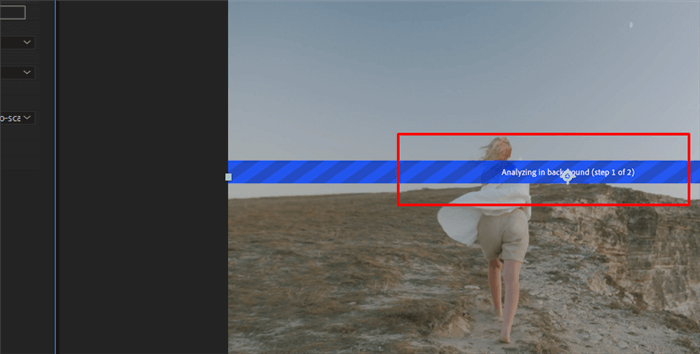
Analyze the Footage
Step 8. If you’re satisfied, go to “Composition”> “Add to Render Queue,” adjust the render settings if needed, and click “Render” to export your stabilized video.
Method 2. Using the Tracker Panel
Utilizing the Tracker panel is another method to stabilize video in After Effects without using Warp Stabilizer. This method manually sets tracking points to follow specific areas in your footage. By placing tracking boxes on key points, you can stabilize the motion in your video with more precision and control. It’s a great option if you want to focus on stabilizing a specific part of the footage. Here are the steps for motion tracking using the Tracker panel:
Step 1. Open the Tracker Panel by going to “Window”> “Tracker Panel.”
Step 2. Select “Stabilize Motion” to begin the process.
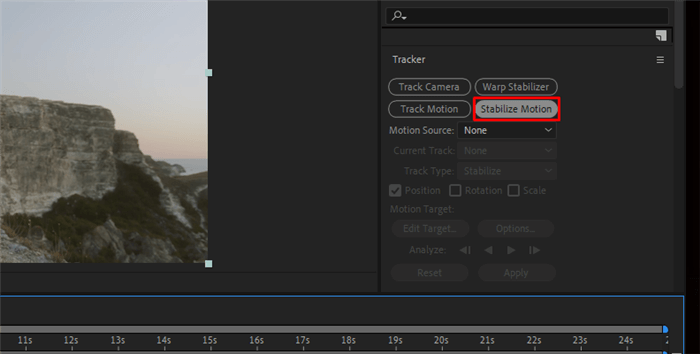
Click Stabilize Motion
Step 3. A tracking box will appear on your screen. Move and adjust it to a well-lit, clear area of the object or person you want to track.
Adjust the Tracking Box
Step 4. Play back your video to check the tracking. If it drifts or becomes inaccurate, pause and adjust the tracking box as needed.
Step 5. Once you’re happy with the tracking, click “Apply” to save your changes. Finally, export your composition.
How to Stabilize Video in Post-Production with AI Tool – AnyEnhancer
AnyEnhancer uses cutting-edge AI models to enhance and stabilize video footage efficiently. The Frame Interpolation model is an AI video stabilizer, particularly effective for stabilizing video. It effectively increases the frame rate by inserting new frames between the old ones, making the motion look smoother and the video quality better. This model allows you to stabilize the footage, making it look less shaky and more professional.
Besides Frame Interpolation, AnyEnhancer offers several other powerful models. The Face Restoration model enhances and clarifies faces in blurry videos by improving facial details. The Colorize Model gives color to the monochrome videos and brings out the colorful looks of the videos. Color Enhancement increases the luminance and contrast of the compressed videos so that the colors in the videos appear to be more vibrant. The Denoise model eliminates visual noise and grain to improve general video quality, and the Resolution Enhancement increases the video’s resolution by 2K or 4K for higher definition and clarity.
Key Features:
- Intelligent Enhancement applies super-resolution and facial enhancement to make details clearer and improve video quality.
- Enhances facial details in blurry videos for better clarity through its Face Restoration Model.
- Enhances grey video to a colored one using the Colorize Model to enliven the footage further.
- Brightens and deepens the colors for a more vivid viewing experience through the Color Enhancement Feature.
- Reduces noise to produce clean and better-looking videos with the Denoise Model.
Now, let’s explore the simple steps to use AnyEnhancer for stabilizing any video:
Step 1. Free download and install AnyEnhancer on your computer.
Free Download for all windows & 100% safe Free Download for all mac & 100% safe
Free Download100% Clean & Safe
Step 2. Open the application and click “Upload Video” or drag your file into the program.

Upload the Original Video
Step 3. Select the “Frame Interpolation” option to start the stabilization process.
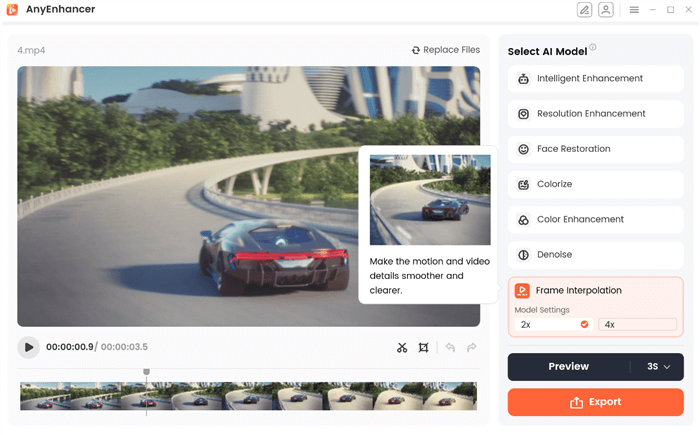
Frame Interpolation Model
Step 4. Click “Preview” to compare the enhanced video and the original.

Preview Frame Interpolation Effect
Step 5. If you’re happy with the preview, click “Export.” Enter a file name and format, choose your save location, and click “Export” again to finalize the process.
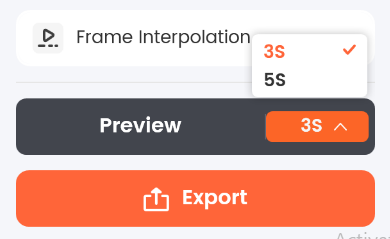
Choose the Preview Duration
FAQs on How to Stabilize Video in After Effects
How do you stabilize a video in a post?
Import your video into AnyEnhancer, select the “Frame Interpolation” option, and preview the results. If satisfied, export the stabilized video for a smoother look.
How to stabilize a shaky video?
Warp Stabilizer in After Effects can help you! Apply it to your footage, and it will automatically analyze and adjust the video to reduce shake and make it smoother. You can also utilize AnyEnhancer’s Frame Interpolation model to stabilize shaky footage.
Do I need to stabilize all my videos?
Not all videos need stabilization. Use it only if the footage is noticeably shaky or has distracting motion.
Final Words
Stabilizing video footage can significantly improve its quality and professional appearance. Whether you use Adobe After Effects with tools like Warp Stabilizer or more manual methods, smoothing out shaky video is essential for a polished result. For those seeking an easy and effective solution, AnyEnhancer offers advanced AI models like Frame Interpolation that can automatically enhance and stabilize your video with minimal effort. We recommend trying AnyEnhancer to effortlessly boost your video’s quality and achieve smooth, professional-looking results in no time.
Product-related questions? Contact Our Support Team to Get Quick Solution >

